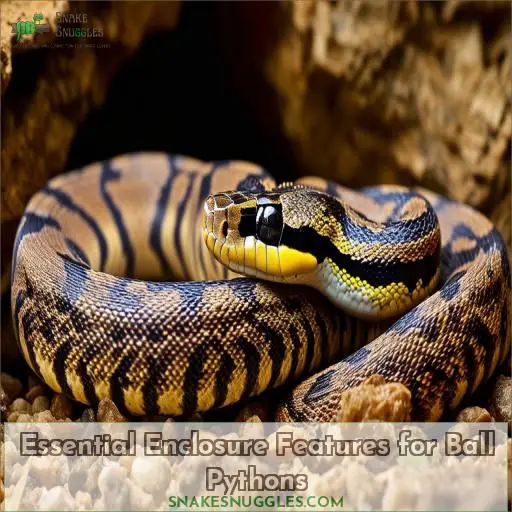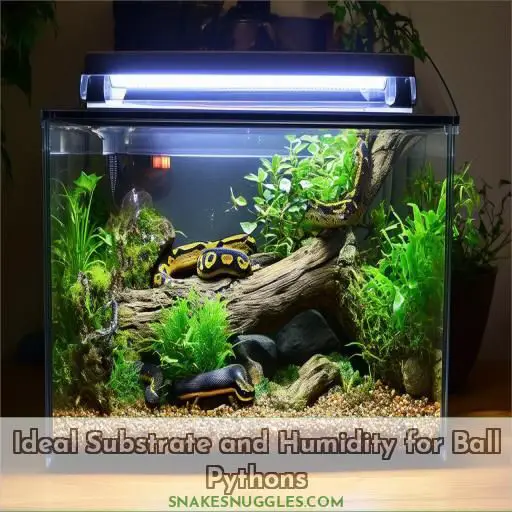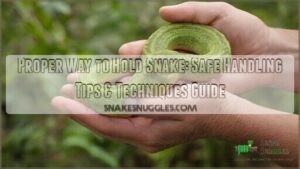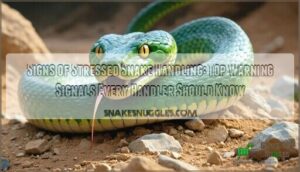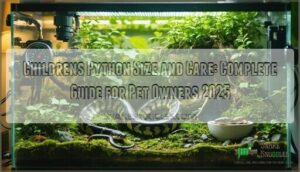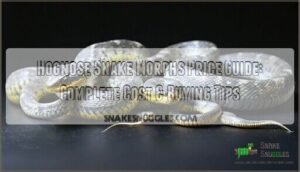This site is supported by our readers. We may earn a commission, at no cost to you, if you purchase through links.
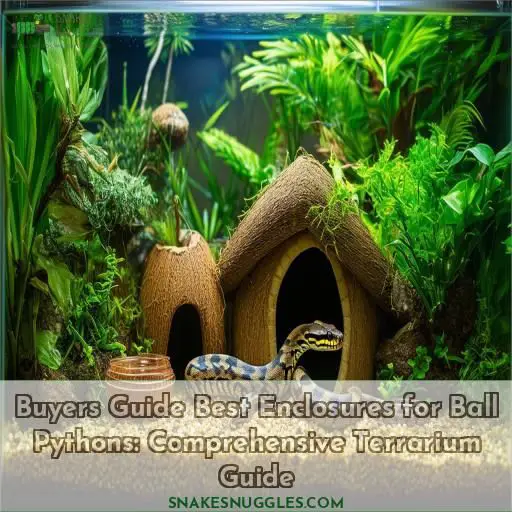 For ball python owners seeking the ideal buyers guide for the best enclosures, you’ll want a front-opening terrarium with ample space for your snake’s adult size.
For ball python owners seeking the ideal buyers guide for the best enclosures, you’ll want a front-opening terrarium with ample space for your snake’s adult size.
The Repti Zoo 120 Gallon Reptile Tank fits the bill, offering a secure, raised design perfect for desert or rainforest setups.
Make certain your enclosure’s width matches your python’s length, while the length and height are half that size – a 4’x2’x2′ PVC is the minimum starter.
Prioritize substrate like Josh’s Frogs Coco Select for proper humidity levels around 60%, and invest in an automatic misting system.
With the right dimensions and features, your slithering companion will thrive. But there’s more to explore for the perfect ball python paradise.
Table Of Contents
- Key Takeaways
- Best Enclosures for Ball Pythons
- Ideal Enclosure Dimensions for Adult Ball Pythons
- Essential Enclosure Features for Ball Pythons
- Ideal Substrate and Humidity for Ball Pythons
- Frequently Asked Questions (FAQs)
- What is the best type of enclosure for a ball python?
- What is the best setup for a ball python?
- What is the ultimate ball python habitat?
- Is a 40 gallon terrarium good for a ball python?
- What is the optimal temperature range for ball pythons?
- How often should the enclosure be cleaned?
- Can ball pythons be housed together?
- When should a hatchling be moved to a larger enclosure?
- What are the signs of an unhealthy ball python?
- Conclusion
Key Takeaways
- Size matters, my friend! A ball python’s enclosure should be roomy enough for them to stretch out and get their slither on – at least 4 feet long, 2 feet wide, and 2 feet tall for an adult. Nothing cramped or claustrophobic for these majestic noodles!
- Humidity is key to keeping your scaly buddy happy and healthy. An automatic misting system is like having a personal raincloud for your python, keeping things nice and moist without you having to constantly spritz. It’s a game-changer!
- Substrate is more than just fancy dirt – it’s their cozy little slice of the rainforest. Josh’s Frogs Coco Select is the crème de la crème, a luxurious blend of coconut husk, peat moss, and bark that’ll make your python feel right at home.
- Front-opening enclosures are a total lifesaver! No more wrestling with your snake to get them out or clean their digs. It’s like having a python penthouse suite with easy access and escape-proof locks to keep your slithery roommate safe and sound.
Best Enclosures for Ball Pythons
For ideal housing, consider the Repti Zoo 120 Gallon Reptile Tank, an enclosure planned with ball python requirements in mind. Its sizable dimensions provide ample space for an adult snake, while its front-opening design and secure locking features guarantee both easy access and escape prevention.
1. Repti Zoo 120 Gallon Reptile Tank
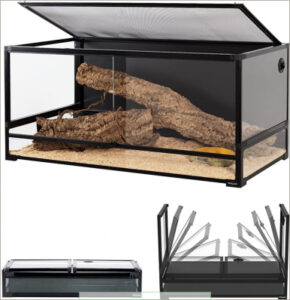
The Repti Zoo 120 Gallon Reptile Tank is a top choice for ball python enclosures.
Its front-opening doors provide easy access.
The raised bottom accommodates substrate heaters.
The waterproof base offers versatility for rainforest or desert setups.
With a patented folding design and security locks, it’s both convenient and escape-proof.
The black-out PVC back reduces stress.
The ventilated screen top allows UV/infrared penetration.
This durable, feature-packed tank offers your ball python a secure, customizable home, ideal for preventing stress and aggression
.
Best For: Ball python enclosures and other large reptile pets.
- Raised bottom for substrate heaters
- Waterproof base for rainforest or desert setups
- Patented folding design for easy storage
- Not suitable for small reptiles
- May be too large for some spaces
- May require additional accessories (e.g., substrate heater)
Ideal Enclosure Dimensions for Adult Ball Pythons
When selecting an enclosure for an adult ball python, it’s essential to provide ample space for the snake to move and thermoregulate effectively.
The recommended dimensions are a width equal to the snake’s length, a length of at least half the snake’s length, and a height of at least half the snake’s length. The minimum starter size for a PVC enclosure is 4’x2’x2′.
These dimensions guarantee the snake has sufficient space to exhibit natural behaviors and maintain a healthy weight. They also allow for appropriate temperature and humidity gradients.
Width: Adult Snake Length
You’ll want the enclosure width to guarantee your ball python’s adult length. This guarantees enough space for comfortable coiling and stretching. Consider:
- Measure your python to get its precise length
- Set the enclosure width as the minimum dimension
- Adult size varies, so plan for the largest potential
- A PVC enclosure meets baseline width necessities
- Length calculation allows for proper morphology and behavior
Length: 1/2 Adult Snake Length
For adult ball pythons, guarantee the enclosure length is at least half the snake’s full-grown size. This promotes natural exploratory behaviors and allows ample space for thermoregulation and digestion. Proper enclosure length also facilitates air circulation and substrate cleanliness, key factors in maintaining a healthy, low-stress environment.
Height: 1/2 Adult Snake Length
For adult ball pythons, make certain the enclosure height is at least half their total body length. This allows sufficient vertical space for thermoregulation, exercising muscles, and displaying natural behaviors like climbing. PVC enclosures offer ideal insulation, but glass terrariums may require additional heating sources to maintain proper temperatures.
Minimum Starter Size: 4’x2’x2′ PVC
You’ll want to start with at least a 4’x2’x2′ PVC enclosure for an adult ball python. This size provides ample floor space, while the 2′ height allows for proper humidity levels with loose soil substrate 2-4" deep. It’s the perfect starter habitat for new owners – a deluxe care guide in the reptile world.
Essential Enclosure Features for Ball Pythons
When selecting an enclosure for your ball python, prioritize front-opening designs with secure lid locks to prevent escapes. Regular spot-cleaning after defecations and complete substrate replacements every 3-4 months, along with a thorough deep-clean every 6 months, are essential for maintaining a healthy environment.
Front-opening Preferred
You’ll want a front-opening enclosure for ideal:
- Viewing angles and interaction
- Access for maintenance and cleaning
- Secure transportation of your snake
- Escape-proof construction for safety
- Ease of feeding and handling
Having a front-opening design provides security and convenience.
Secure Lid Locks
You need secure lid locks to prevent escapes. Consider these lock types:
| Lock Type | Child Safety | Escape Prevention |
|---|---|---|
| Bolt Lock | High | High |
| Latch Lock | Medium | Medium |
| Clamp Lock | Low | High |
Ensure proper hinge security and lock placement.
Escape Prevention
You’ll also want to guarantee your enclosure is escape-proof. Secure lid locks and front-opening designs make ball python habitats safe, preventing clever snakes from finding exit routes.
Spot-clean After Defecation
You’ll need to spot-clean your ball python’s enclosure after each defecation to maintain proper hygiene. Frequent spot-cleaning prevents odors, diseases, and unsightly messes.
Substrate Replacement Every 3-4 Months
You’ll need to replace the substrate every 3-4 months to maintain proper substrate hygiene and humidity retention. Fresh substrate assists with shedding and provides enrichment options while maintaining the essential temperature gradient.
Deep-clean Every 6 Months
Deep-cleaning your ball python’s enclosure every six months is paramount for maintaining proper hygiene. Use F10SC, Rescue, or bleach solution to eliminate any potential bacterial build-up, ensuring a healthy environment.
Ideal Substrate and Humidity for Ball Pythons
For ideal ball python housing, you’ll want to provide a loose soil substrate that’s 2-4 inches deep, such as Josh’s Frogs Coco Select blend of coco husk, peat moss, and bark (around 60 quarts for most adult enclosures). An automatic misting system is highly recommended to maintain the necessary 60-80% humidity levels that ball pythons require.
Loose Soil Substrate: 2-4 Deep
You’ll want a loose soil substrate with a depth between 2-4 inches. Ball pythons thrive in naturalistic environments with burrowing opportunities, moisture retention, and enrichment. An ideal substrate contains materials like coco husk, peat moss, and bark chips, providing structure, drainage, and natural aromas.
Josh’s Frogs Coco Select: Coco Husk, Peat Moss, Bark
You’ll want to use Josh’s Frogs Coco Select, a blend of coco husk, peat moss, and bark, for your ball python’s substrate. It provides:
- Excellent moisture retention
- Natural aeration and drainage
- Ideal texture for burrowing
- Organic composition for microbial growth
- Earthy aroma for enrichment
This premium substrate mix ensures your python thrives in its enclosure.
At Least 60 Quarts
You’ll need at least 60 quarts (around 6 bags) of Josh’s Frogs Coco Select loose substrate for your adult ball python’s enclosure. This depth of 2-4 inches provides ample humidity retention, essential for proper shedding and overall health. The coco husk, peat moss, and bark mixture mimics their natural environment perfectly.
Automatic Misting System for Humidity
You’ll need an automatic misting system to maintain ideal humidity levels. Look for programmable misters that allow adjusting misting frequency and duration. Proper humidity control prevents respiratory issues and aids shedding. Distilled or reverse osmosis water is best to avoid mineral buildup. Monitor the system and clean it regularly for efficient operation.
Frequently Asked Questions (FAQs)
What is the best type of enclosure for a ball python?
The best enclosure for a ball python is a front-opening PVC or HDPE enclosure. It’s secure, durable, and maintains ideal humidity levels. Verify it meets the size requirements for your snake’s length and provides adequate hides, climbing branches, and substrate depth.
What is the best setup for a ball python?
Did you know over 60% of ball python owners make mistakes with their enclosure setup? An ideal habitat includes a 4’x2’x2′ PVC enclosure with secure locks, 60 quarts of premium substrate like Josh’s Frogs Coco Select, two hides with sphagnum moss, multiple climbing branches, and a radiant heat panel for thermoregulation.
What is the ultimate ball python habitat?
For the ultimate ball python habitat, create a 4’x2’x2′ PVC enclosure with deep coconut substrate, heated basking areas, humid hides, sturdy branches for climbing, and plenty of clutter for security. Make it a cozy oasis designed to meet your snake’s needs.
Is a 40 gallon terrarium good for a ball python?
A 40-gallon terrarium falls short for an adult ball python. It doesn’t provide adequate floor space or height for this semi-arboreal species. For a single adult, experts recommend enclosures at least 4 feet long, 2 feet wide, and 2 feet tall to meet their spatial needs.
What is the optimal temperature range for ball pythons?
Ball pythons thrive at 90-95°F on the warm end and 78-83°F on the cool end. Maintaining a proper temperature gradient lets them thermoregulate and digest properly.
How often should the enclosure be cleaned?
You’ll want to spot-clean after any messes, replace substrate every 3-4 months, and deep-clean the entire enclosure every 6 months using a reptile-safe disinfectant. Regular cleaning prevents bacteria buildup, odors, and potential health issues.
Can ball pythons be housed together?
No, ball pythons should never be housed together. These solitary snakes are highly prone to stress, fights, and even cannibalism when cohabitated. Provide each individual its own properly-sized enclosure for ideal health and well-being.
When should a hatchling be moved to a larger enclosure?
You’ll want to move your ball python into a larger enclosure once it reaches around 18-24 inches long. This usually happens within the first year as hatchlings have rapid growth spurts. Closely monitor their size to determine the ideal upgrade timing.
What are the signs of an unhealthy ball python?
Signs of an unhealthy ball python include lack of appetite, lethargy, skin issues like blisters or discoloration, discharge from the mouth or nose, and abnormal shedding. If you notice these, consult an experienced reptile vet immediately.
Conclusion
Providing the cosmic dance for your ball python’s terrestrial voyage, a buyers guide for the best enclosures amalgamates crucial facets. Repti Zoo’s 120-gallon tank, ideal dimensions, escape-proof features, spot-clean regimens, and an automated misting system fostering 60% humidity guarantee your slithering companion thrives. With a thorough terrarium customized for their needs, these majestic creatures can truly flourish in their captive paradise.


